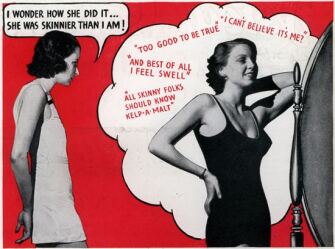
What’s the best way to encourage positive body image in girls? Have older boys tell them what the perfect woman looks like, according to a UK child health expert.
Aric Sigman, author of The Body Wars: Why Body Dissatisfaction Is at Epidemic Proportions, presented on the topic today at a professional development event hosted in London by the Headmasters’ and Headmistresses’ Conference. According to The Telegraph, Sigman says that teachers should have boys in higher grades talk to female students about the non-physical qualities that they find attractive, like personality.
The boys should also explain that stereotypical ideas of attractiveness aren’t necessarily true, Sigman says: “There are women who appear model-perfect visually but are just not sexy and there are girls who do not seem model material but are very attractive.” He added, according to The Daily Mail, “Today men are in a position to countercheck the prevailing highly damaging generalisation that female body fat is unattractive and disliked by males.”
So basically, the best way to make girls worry less about having a perfect body is to have teenage boys—who are well-known for their tact, honesty, and sense of judgment—tell them what they like in a woman.
Not everyone thinks this is especially wise approach. In a response to Sigman (also for The Telegraph), Natasha Devon, founder of the UK-based body image and mental health education group Self-Esteem Team, took issue with the idea that girls’ self-confidence should be based on what their male peers think of them. She writes, “Our relationship with our bodies and sense of self-worth shouldn’t be subcontracted to anyone. It should come from within.”
Sigman does make some reasonable points, pointing out that the lack of body diversity in media can contribute to poor body image among girls. However, Devon argues that Sigman’s advice to educators would be ineffective in combating a problem caused by the media and beauty industry, not by men’s personal opinions of women. If boys and men aren’t causing the problem, she says, it’s unreasonable to expect them to be able to fix it.
Along with several other voices of dissent on Twitter, Devon has also pointed out Sigman overlooks the body image issues that teenage boys often face themselves—not to mention the fact that not all girls are interested in what boys are attracted to, nor are all boys attracted to girls.
Teachers who are interested in talking about body image with their students have plenty of options to choose from. The Guardian Teacher Network has a collection of resources for working with younger students, and the University of Washington has a similar page for teens. Other organizations provide ideas for lessons about stereotypes, discussions about obesity, and more. None of these options, however, involve having boys give their opinions on girls’ bodies.
Image: A 1934 ad for Kelp-a-Malt weight-gain tablets shows that while ideas about dieting and the “ideal” body have changed over time, body image issues are nothing new. Image via Modern Mechanix.